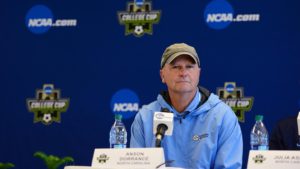By Dave Lohse

Over the past six weeks, I’ve lost count of the number of interviews I’ve set up for University of North Carolina head women’s soccer coach Anson Dorrance. It seems to be this way every four years when a FIFA Women’s World Cup rolls around. But 2019 seemed especially frenzied in terms of the media folks who wanted to connect with the long-time Carolina mentor.
As I texted with Anson Monday afternoon to set up another interview, I mentioned that this World Cup, at its conclusion, ended up being virtually everything a Tar Heel women’s soccer fan could hope for. If pride is a deadly sin, consider the program in Chapel Hill sinful after the riches of the past month.
The only way I can imagine the World Cup producing a better story line for the Tar Heel program was if New Zealand, which featured 2016 UNC graduate Katie Bowen, had reached the knockout phase.
The most obvious story line was the fourth World Cup title for the United States. Dorrance coached the U.S. to its first World Cup title in 1991 with nine Tar Heels on that squad. Eight Carolina players competed for the 1999 World Cup champions who prevailed in a shootout in that epic final match at the Rose Bowl against China. The U.S. would wait an agonizing 16 more years before it won again in 2015 in Canada, routing Japan 5-2 in the finals. There were six Tar Heels on that U.S. squad.
Sunday, with a 2-0 win over the Netherlands, brought a fourth World Cup to the Red, White & Blue. Five more Tar Heels represented the U.S. in this World Cup, meaning 28 roster spots in those four victorious World Cups featured UNC players. This year’s group included starters Tobin Heath at forward and Crystal Dunn at left back as well as reserves Ashlyn Harris, Allie Long and Jessica McDonald. Heath and Harris both won titles in 2015.
Dunn, the last cut from the 2015 team, has developed into one of the world’s premier left backs although her more natural position may either be in the midfield or forward line. Long and McDonald had both appeared lost in the shuffle of U.S. National call ups over the past 18 months but both made the team through hard work and had their own inspiring story lines. McDonald was the only mother on the 2019 American squad.
Even when stretched to their limit against Spain, France and England in the knockout phase, one always got the sense the Americans would eventually wear the crown. The host French controlled play in many ways in the quarterfinal but could not overcome a 2-0 deficit. The English were tough as nails but the Americans prevailed by seeing out the match in a classy way while also benefitting from a VAR review and a poorly taken penalty kick.
When the U.S. got to the final, it almost seemed anti-climactic but in all honesty, no World Cup final can be anti-climactic. The U.S. outshot the Netherlands 17-5 and goals in the 61st and 69thminutes safely ushered the U.S. onto the highest level of the awards podium afterwards.
The Dutch were a great story in their own right, having gone unbeaten until the final and prevailing by winning games repeatedly in the second half. They held the U.S. to a scoreless tie at intermission but eventually the U.S. wore Holland down. The Dutch were coached superbly by Sarina Wiegman, another Tar Heel connection.
Dorrance had seen Wiegman play in 1988 in a FIFA event in Europe and he invited her to come to school in Chapel Hill. Wiegman played on Carolina’s 1989 NCAA championship team led by seniors Shannon Higgins and Carla Werden and a pair of fellow freshmen named Mia Ham and Kristine Lilly. All four of those Tar Heels would play on the first U.S. champion team coached by Dorrance in 1991. Thirty years after playing in Chapel Hill, Wiegman was coaching in a World Cup final for her native country.
I can’t finish this column without shout outs to Lucy Bronze and Heather O’Reilly as well. Bronze, who played as a freshman at Carolina in 2009, won the Silver Ball as the tournament’s second best player. She had a brilliant post-season run with Carolina in 2009 as she helped lead UNC to its 21st national championship. She returned to her native England the following year to play professionally and has developed into the best right back in the world.
Finally, you could not turn on your television without appreciating the work of O’Reilly, the 2006 National Player of the Year at Carolina and two-time NCAA champion. O’Reilly won Olympic gold medals in 2004, 2008 and 2012 and a World Cup title in 2015. Her expert work in the studio in Paris, with FOX mainstays Rob Stone and Alexi Lalas, was stellar and her Twitter feed a joy to follow.
But really, it all comes back to Dorrance, the architect of the Carolina women’s soccer program since 1979. Through his hard work he has built a program that has influenced the game at every level. The 2019 World Cup was just another chance to appreciate the ties Chapel Hill has around the world to the beautiful game.
Let’s do it again in 2020 when the Olympics arrive in Japan. In the meantime, continue to enjoy the Carolina Blue exploits that surrounded this most momentous of quadrennial event.
(Originally published on goheels.com. Dave Lohse is UNC’s Associate Athletics Communication Director)
